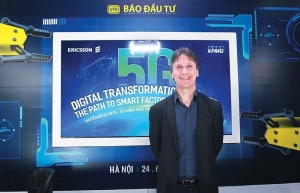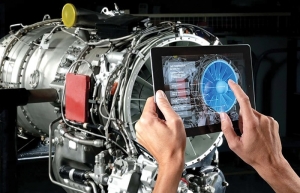Transforming healthcare through 5G
Wearable devices, secure online consultations, and remote procedures like robotic surgery will improve resource efficiency and meet consumer demands for greater convenience and freedom of choice. Healthcare officials across the industry place telecom operators at the top of the list when it comes to partnerships – above app developers and pharmaceutical companies.
 |
| Denis Brunetti - President in Vietnam and Myanmar Ericsson |
Eighty-six per cent of cross-industry decision-makers included in the ConsumerLab report believe operators could provide system integration along with app and service development – in addition to their roles as network providers.
Healthcare will become decentralised, moving from hospitals towards homes. Consumers are frustrated with inconveniences and doctor waiting times; 39 per cent of chronic patients prefer online consultations to face-to-face meetings. Close to two in three consumers say wearables that monitor and administer medication are important to better manage chronic ailments, leading to reduced visits to the doctor. In addition, more than half of those surveyed feel decentralising healthcare to local centres will improve efficiency and address resource scarcity.
Patient data is also centralised, turning hospitals into data centres. Around 35 per cent of consumers say that online access to a central repository of medical records will help them easily manage the quality and efficiency of their care; 45 per cent of cross-industry experts consider the central repository as a breakthrough in healthcare provisioning.
Access to patient data is considered important to improve healthcare. Doctors will become data scientists and data security will become paramount, as 46 per cent of decision-makers already consider data security to be an issue.
Meanwhile, there is increasing dependence on wearables and remote treatments that make 5G essential in order to provide reliable and secure services. Over 55 per cent of consumers worry about their wearable health patches running out of battery; 42 per cent of cross-industry players expect devices connected to 5G networks to consume less power. Some 35 per cent expect 5G to provide reliable low-latency connections, while 47 per cent of telecoms decision-makers say that secure access to an online central repository is a key challenge and expect 5G to address this.
As care moves away from hospitals, increasingly detailed patient information will in fact flow back to the hospitals. Increased use of wearables, sensors, and other connected devices will generate large volumes of diagnostic data, which need to be combined with electronic health records from clinicians and stored at a secured central location.
Paradoxically, as improved healthcare helps people live longer, healthcare systems come under increasing pressure as older patients need more care. The resulting resource shortage is forcing the industry to become more and more dependent on automation, remote treatment, and AI.
AI systems have the potential to provide physicians and researchers with clinically-relevant, real-time information from centralised data repositories. Forty-four per cent of cross-industry decision-makers feel that insights based on analysis of such complex data will speed up diagnosis. Access to patients’ health records during routine consultations can improve diagnosis and reduce medical errors during emergencies.
Although doctors are physically away from patients, their data offers a closer view than ever before. Over 40 per cent say dispersed patient data is a serious concern in the current healthcare system, while 45 per cent feel giving doctors online access to centralised patient data will positively impact healthcare services.
IT holds the promise of reducing costs by providing care away from hospitals and closer to home; whereas increasingly detailed data can move from patients to centralised healthcare repositories, allowing for efficiency gains in diagnosis and treatment.
Next-generation networks will be pivotal in this transformation, providing transmission efficiency in an ecosystem of feedback and alerts, mobility, and low latency. They will become a vehicle for a range of applications, including remote monitoring through medical-grade wearables, virtual doctor-patient interaction, and remotely operated robotic surgery.
With recent advances in communication networks and machine learning, healthcare is one of the key application domains which stands to benefit from many opportunities, including remote global healthcare, hospital services on cloud, remote diagnosis, or surgeries, among others.
One of those advances is network slicing, making it possible to provide high-bandwidth, low-latency and personalised healthcare services for individual users. This is important for patients using healthcare monitoring devices that capture various biological signals such as from the heart, muscles, or brain.
These bio-signals can be acquired from various assistive tech devices, ranging from simple smartwatches that track movement or pulse rate, to complex devices like prosthetic limbs, prosthetic neural systems and cardiac pacemakers. The sensors on such devices collect dense time-series data that needs to be processed in real time with minimal delay.
As healthcare is directly connected to the quality of human life, it has been the primary focus for multiple stakeholders. Assistive technology can significantly transform the quality of life for an individual, hence leveraging communication and machine learning advances for its practical realisation are of utmost importance.
While we note that challenges with security, privacy, and interoperability are still being addressed as methods and regulations evolve, platforms for scalable bio-signal monitoring with robust, timely detection of critical events have an array of beneficiaries and are of strategic business value.
 | The path to success with smart 5G manufacturing in Vietnam With digitalisation and automation taking place in factories in Vietnam, manufacturers are expecting successful transformation ahead to increase factory capabilities and boost agility. Denis Brunetti, president in Vietnam and Myanmar for Ericsson, discussed with VIR’s Bich Thuy how to make it happen with sci-tech advancements. |
 | 5G can change the game in manufacturing As the fastest and most reliable connectivity enabler the world has ever seen, 5G will deliver an array of innovative uses to increase factory capabilities and boost agility. Denis Brunetti, president for Ericsson in Vietnam and Myanmar, explains why freeing operations from wire dependency is the best direction to take. |
 | 4G/5G wireless networks driving digitalisation across industries People are seeing a massive digitalisation wave taking place across industries with reliable and secure connectivity serving as the foundation. |
What the stars mean:
★ Poor ★ ★ Promising ★★★ Good ★★★★ Very good ★★★★★ Exceptional
Themes: Digital Transformation
Related Contents
Latest News
More News
- Businesses ramp up production as year-end orders surge (December 30, 2025 | 10:05)
- Vietjet chairwoman awarded Labour Hero title (December 29, 2025 | 13:06)
- How to unlock ESG value through green innovation (December 29, 2025 | 10:03)
- AI reshapes media and advertising industry (December 29, 2025 | 08:33)
- FPT and GELEX sign deal to develop blockchain tech for global markets (December 29, 2025 | 08:29)
- Vietnam’s GDP forecast to grow by 9 per cent in 2026 (December 29, 2025 | 08:29)
- Women entrepreneurs are key to Vietnam’s economic growth (December 29, 2025 | 08:00)
- Vietnam's top 500 value-creating enterprises announced (December 27, 2025 | 08:00)
- The PAN Group shaping a better future with ESG strategy (December 26, 2025 | 09:00)
- Masan Consumer officially lists on HSX, marking the next phase of value creation (December 25, 2025 | 13:20)

 Tag:
Tag:




















 Mobile Version
Mobile Version